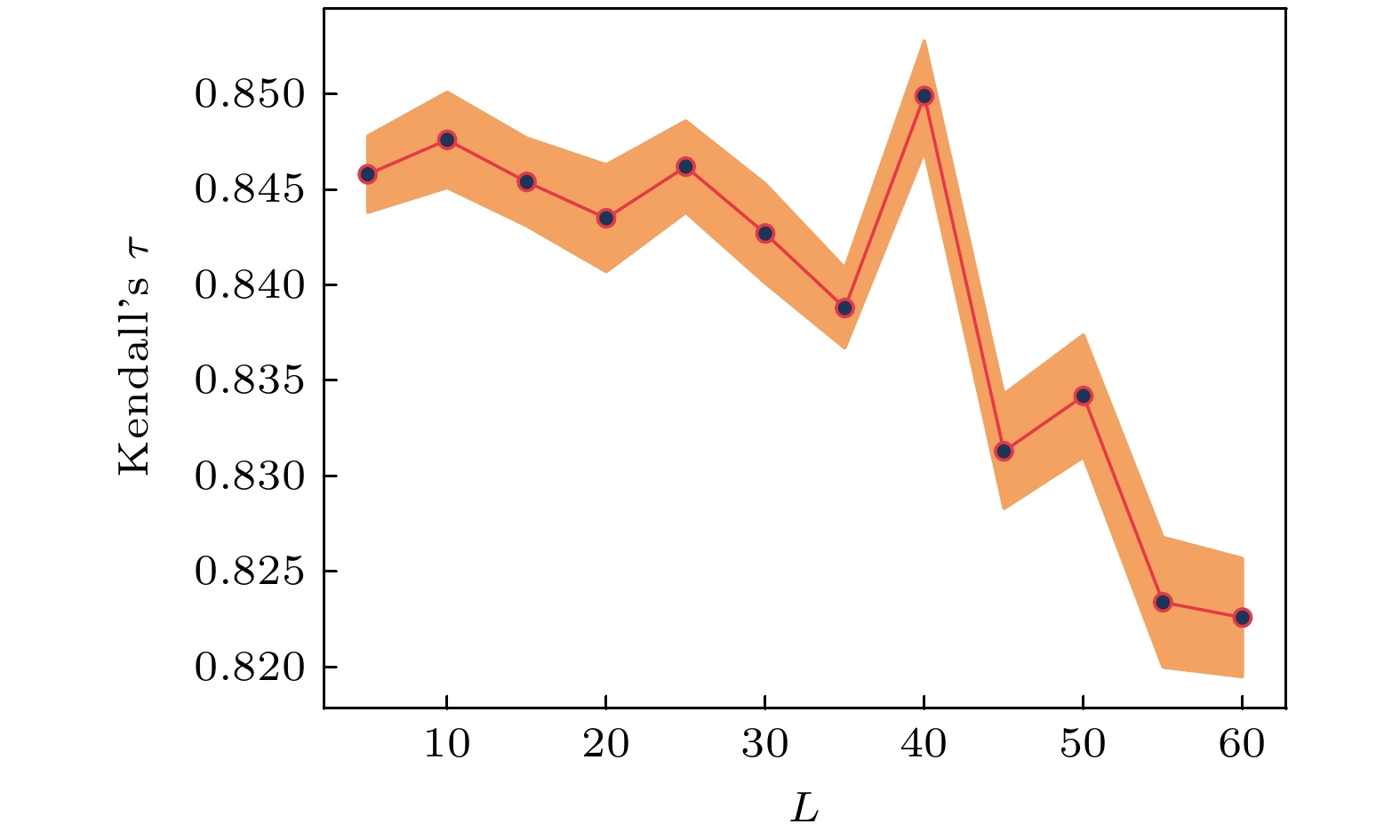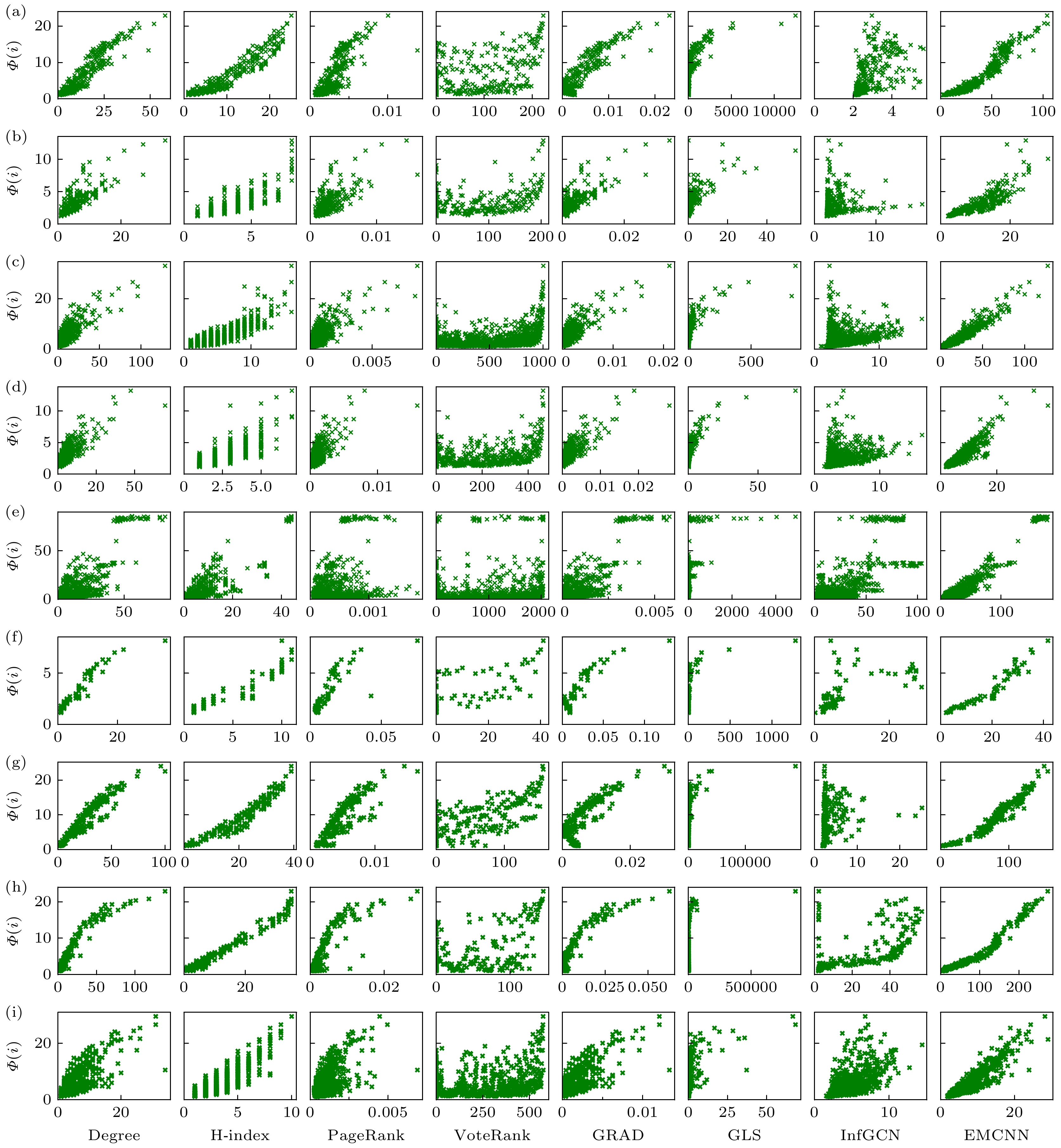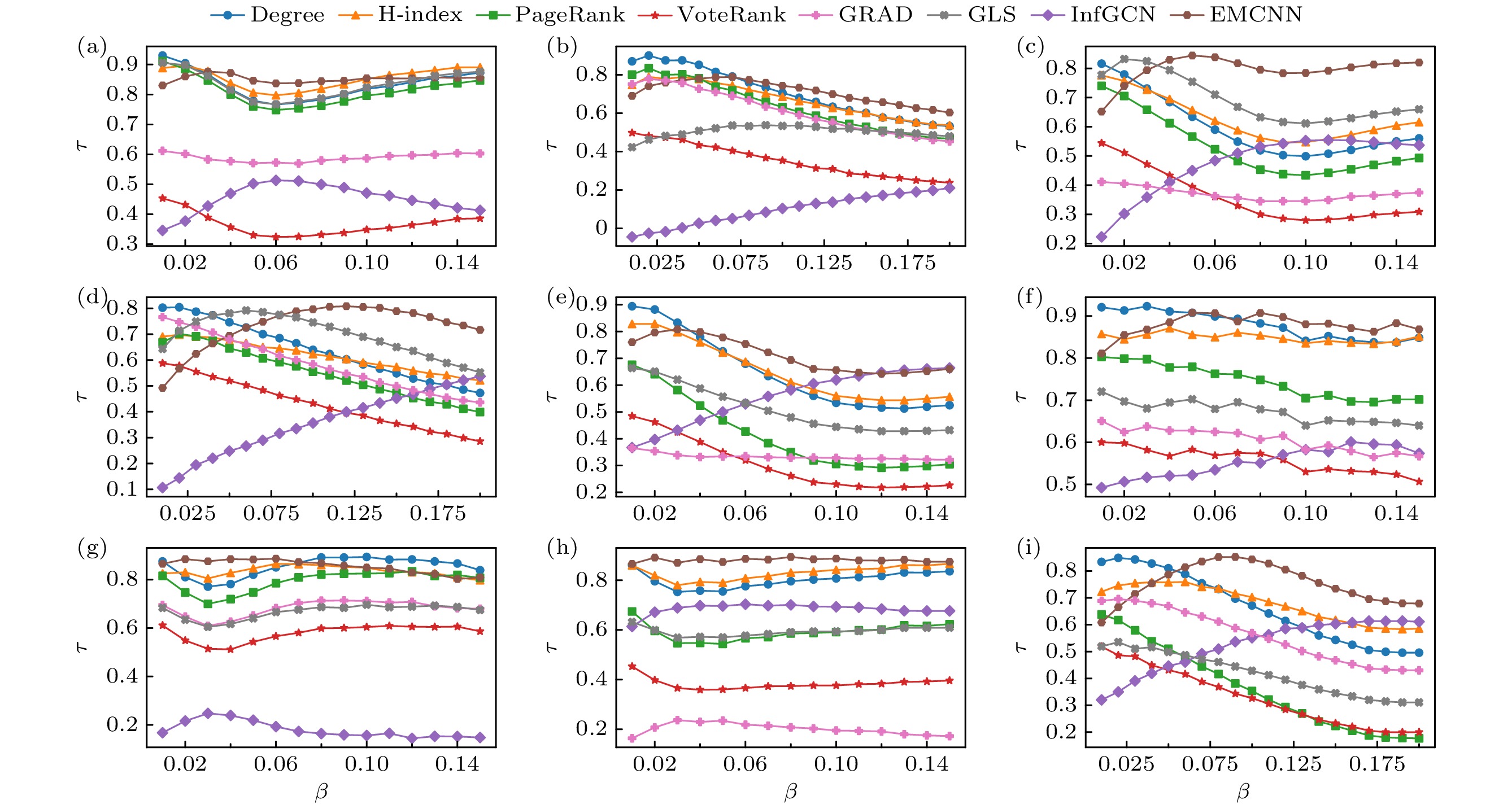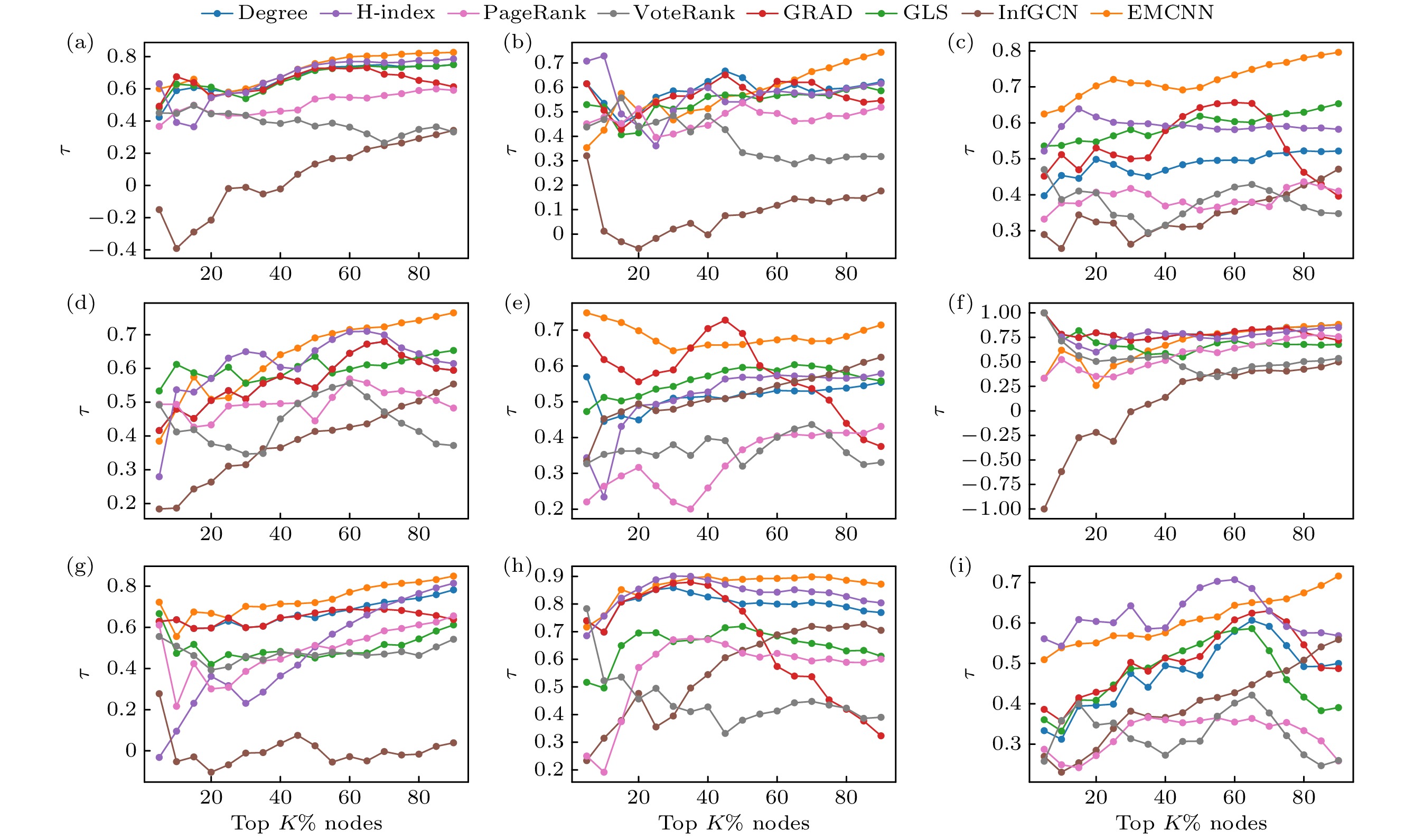-
利用定量分析的方法识别复杂网络中的关键节点, 或者评估某节点相对于其他一个或多个节点的重要程度, 是网络科学研究的热点问题. 针对节点重要性识别中存在的指标权重主观赋值和全局和局部信息融合不足等问题, 本文提出一种基于信息熵赋权的多通道卷积神经网络框架(entropy-based weighted multi-channel convolutional neural network framework, EMCNN). 该方法构建了一种无参熵权分配模型, 通过计算不同节点重要性指标的熵权值, 突破了传统方法依赖经验参数的局限性. 同时, 对全局与局部信息进行解耦重构, 构建多通道特征图, 并结合卷积神经网络的特征提取能力和注意力机制的关键特征融合能力, 实现全局与局部特征的深度融合学习, 从而更精准地识别网络节点的重要性. 为验证该方法的有效性, 本文在9个真实世界网络和3个合成网络上利用SIR模型进行仿真实验, 结果表明EMCNN方法有效克服了评估角度的局限性, 能在不同传播率下对节点的传播影响力进行有效评估, 在相关性及准确性上优于当前主流算法.Identifying key nodes in complex networks or evaluating the relative node importance with respect to others by using quantitative methods is a fundamental issue in network science. To address the limitations of existing approaches—namely the subjectivity in assigning weights to importance indicators and the insufficient integration of global and local structural information—this paper proposes an entropy-weighted multi-channel convolutional neural network framework (EMCNN). First, a parameter-free entropy-based weight allocation model is constructed to dynamically assign weights to multiple node importance indicators by computing their entropy values, thereby mitigating the subjectivity inherent in traditional parameter-setting methods and enhancing the objectivity of indicator fusion. Second, global and local structural features are decoupled and reconstructed into separate channels to form multi-channel feature maps, which significantly enhance the representational capacity of the network structure. Third, by leveraging the feature extraction capabilities of convolutional neural networks and the integration power of attention mechanisms, the framework extracts deep representations of nodes from the multi-channel feature maps, while emphasizing key structural information through attention-based weighting, thus enabling more accurate identification and characterization of node importance. To validate the effectiveness of the proposed method, extensive experiments are conducted on nine real-world networks by using the SIR spreading model, thereby assessing performance in terms of correlation, accuracy, and robustness. The Kendall correlation coefficient is used as the primary evaluation metric to measure the consistency between predicted node importance and actual spreading influence. Additionally, experiments are performed on three representative synthetic networks to further test the model’s generalizability. Experimental results demonstrate that EMCNN consistently and effectively evaluates node influence under varying transmission rates, and significantly outperforms mainstream algorithms in both correlation and accuracy. These findings highlight the powerful generalization ability and wide applicability of this method in the identification of key nodes in complex networks.
-
Keywords:
- entropy /
- convolutional neural network /
- node importance
[1] Lü L Y, Chen D B, Ren X L, Zhang Q M, Zhang Y C, Zhou T 2016 Phys. Rep. 650 1
 Google Scholar
Google Scholar
[2] Pastor-Satorras R, Vespignani A 2001 Phys. Rev. Lett. 86 3200
 Google Scholar
Google Scholar
[3] Albert R, Barabási A L 2002 Rev. Modern Phys. 74 47
 Google Scholar
Google Scholar
[4] Zeng Y 2020 Neurocomputing 416 158
 Google Scholar
Google Scholar
[5] Albert R, Jeong H, Barabási A L 1999 Nature 401 130
 Google Scholar
Google Scholar
[6] Lü L, Zhou T, Zhang Q M, Stanley H E 2016 Nat. Commun. 7 10168
 Google Scholar
Google Scholar
[7] Xu X, Zhu C, Wang Q Y, Zhu X Q, Zhou Y 2020 Sci. Rep. 10 2691
 Google Scholar
Google Scholar
[8] Brin S, Page L 1998 Computer Networks and ISDN Systems 30 107
 Google Scholar
Google Scholar
[9] Freeman L C 1977 Sociometry 40 35
 Google Scholar
Google Scholar
[10] Sabidussi G 1966 Psychometrika 31 581
 Google Scholar
Google Scholar
[11] Kitsak M, Gallos L K, Havlin S, Liljeros F, Muchnik L, Stanley H E, Makse H A 2010 Nat. Phys. 6 888
 Google Scholar
Google Scholar
[12] Bonacich P 1987 Am. J. Sociology 92 1170
 Google Scholar
Google Scholar
[13] Lü L, Zhang Y C, Yeung C H, Zhou T 2011 PLoS One 6 21202
 Google Scholar
Google Scholar
[14] Curado M, Tortosa L, Vicent J F 2023 Inform. Sci. 628 177
 Google Scholar
Google Scholar
[15] Ullah A, Wang B, Sheng J F, Long J, Khan N, Sun Z J 2021 Expert Syst. Appl. 186 115778
 Google Scholar
Google Scholar
[16] Liu W Z, Lu P L, Zhang T 2023 IEEE Trans. Comput. Soc. Syst. 11 2105
 Google Scholar
Google Scholar
[17] Ruan Y R, Liu S Z, Tang J, Guo Y M, Yu T Y 2024 Expert Syst. Appl. 268 126292
 Google Scholar
Google Scholar
[18] Rezaei A A, Munoz J, Jalili M, Khayyam H 2023 Expert Syst. Appl. 214 119086
 Google Scholar
Google Scholar
[19] Li X Y, Zhang Z J, Liu J M, Gai K K 2019 Proceedings of the 2019 ACM International Symposium on Blockchain and Secure Critical Infrastructure New York, USA, May 9–12, 2019 p13
[20] Zhao G H, Jia P, Zhou A M, Zhang B 2020 Neurocomputing 414 18
 Google Scholar
Google Scholar
[21] Yu E Y, Wang Y P, Fu Y, Chen D B, Xie M 2020 Knowl-Based Syst. 198 105893
 Google Scholar
Google Scholar
[22] Zhang M, Wang X J, Jin L, Song M, Li Z Y 2022 Neurocomputing 497 13
 Google Scholar
Google Scholar
[23] 王博雅, 杨小春, 卢升荣, 唐勇平, 洪树权, 蒋惠园 2024 73 226401
 Google Scholar
Google Scholar
Wang B Y, Yang X C, Lu S R, Tang Y P, Hong S Q, Jiang H Y 2024 Acta Phys. Sin. 73 226401
 Google Scholar
Google Scholar
[24] Chen L Y, Xi Y, Dong L, Zhao M J, Li C L, Liu X, Cui X H 2024 Inf. Process. Manag. 61 103775
 Google Scholar
Google Scholar
[25] Tang J X, Qu J T, Song S H, Zhao Z L, Du Q 2024 J. King Saud Univ. –Comput. Inf. Sci. 36 102183
 Google Scholar
Google Scholar
[26] Zhang P, Wang J L, Li X J, Li M H, Di Z R, Fan Y 2008 Physica A 387 6869
 Google Scholar
Google Scholar
[27] Zhang J X, Chen D B, Dong Q, Zhao Z D 2016 Sci. Rep. 6 27823
 Google Scholar
Google Scholar
[28] Hajarathaiah K, Enduri M K, Dhuli S, Anamalamudi S, Cenkeramaddi L R 2023 IEEE Access 11 808
 Google Scholar
Google Scholar
[29] Sheng J F, Dai J Y, Wang B, Duan G H, Long J, Zhang J K, Guan K R, Hu S, Chen L, Guan W H 2020 Physica A 541 123262
 Google Scholar
Google Scholar
[30] Kermack W O, McKendrick A G 1927 Proc. R. Soc. Lond. Ser. A - Contain. Pap. Math. Phys. Charact. 115 700
 Google Scholar
Google Scholar
[31] Bae J, Kim S 2014 Physica A 395 549
 Google Scholar
Google Scholar
[32] Kendall M G 1945 Biometrika 33 239
 Google Scholar
Google Scholar
[33] Barabási A L, Albert R 1999 Sci. 286 509
 Google Scholar
Google Scholar
[34] Dorogovtsev S N, Goltsev A V, Mendes J F F 2006 Phys. Rev. Lett. 96 040601
 Google Scholar
Google Scholar
[35] Blagus N, Šubelj L, Bajec M 2012 Physica A 391 2794
 Google Scholar
Google Scholar
[36] Newman M E J 2006 Phys. Rev. E 74 036104
 Google Scholar
Google Scholar
[37] Rual J F, Venkatesan K, Hao T, Hirozane-Kishikawa T, Dricot A, Li N, Berriz G F, Gibbons F D, Dreze M, Ayivi-Guedehoussou N, Klitgord N, Simon C, Boxem M, Milstein S, Rosenberg J, Goldberg D S, Zhang L V, Wong S L, Franklin G, Li S M, Albala J S, Lim J, Fraughton C, Llamosas E, Cevik S, Bex C, Lamesch P, Sikorski R S, Vandenhaute J, Zoghbi H Y, Smolyar A, Bosak S, Sequerra R, Doucette-Stamm L, Cusick M E, Hill D E, Roth F P, Vidal M 2005 Nature 437 1173
 Google Scholar
Google Scholar
[38] Jeong H, Mason S P, Barabási A L, Oltvai Z N 2001 Nature 411 41
 Google Scholar
Google Scholar
[39] Knuth D E 1993 The Stanford GraphBase: A Platform for Combinatorial Computing (New York: ACM Press
[40] Gleiser P M, Danon L 2003 Adv. Complex Syst. 6 565
 Google Scholar
Google Scholar
[41] Colizza V, Pastor-Satorras R, Vespignani A 2007 Nat. Phys. 3 276
 Google Scholar
Google Scholar
[42] Kunegis J 2013 Proceedings of the 22nd International Conference on World Wide Web Rio de Janeiro, Brazil, May 13–17, 2013 p1343
[43] Batagelj V, Mrvar A 1998 Connections 21 47
 Google Scholar
Google Scholar
-
图 2 一跳邻接矩阵${\boldsymbol{E}}$提取示意图, 展示了从一个包含8个节点和11条边的局部网络中, 获取节点3的大小为$L = 5$的一跳邻接矩阵, 首先识别与节点3直接相连的邻居节点(节点1, 2, 4, 6, 7), 并依据其度值${W^{{\text{DC}}}}$进行降序排序, 随后根据排序后的节点顺序构建出节点3的一跳邻接矩阵${{\boldsymbol{E}}_3}$
Fig. 2. Illustration of one-hop adjacency matrix ${\boldsymbol{E}}$ extraction. The figure shows the process of extracting a one-hop adjacency matrix of size $L = 5$ for node 3 from a local network with 8 nodes and 11 edges, the direct neighbors of node 3 (nodes 1, 2, 4, 6, and 7) are first identified and then sorted in descending order based on their degree values ${W^{{\text{DC}}}}$, finally, the one-hop adjacency matrix ${{\boldsymbol{E}}_3}$ is constructed according to the sorted neighbor order.
图 4 8种方法预测的节点影响力与SIR传播感染节点数的相关性(由于各算法在评分机制和输出尺度上的差异, 横坐标的取值范围不一致) (a) Facebook; (b) Netscience; (c) Protain; (d) Yeast; (e) CA-GrQc; (f) Lesmis; (g) Jazz; (h) USAir; (i) Faa
Fig. 4. Correlation between the node influence predicted by eight algorithms and the number of infected nodes simulated by the SIR model: (a) Facebook; (b) Netscience; (c) Protain; (d) Yeast; (e) CA-GrQc; (f) Lesmis; (g) Jazz; (h) USAir; (i) Faa. Due to differences in scoring mechanisms and output scales among the algorithms, the horizontal axis values are not on a unified scale.
图 5 8种节点排序性方法在9个真实网络上的Kendall相关系数对比 (a) Facebook; (b) Netscience; (c) Protain; (d) Yeast; (e) CA-GrQc; (f) Lesmis; (g) Jazz; (h) USAir; (i) Faa
Fig. 5. Comparison of Kendall correlation coefficient for 8 node ranking methods on 9 networks: (a) Facebook; (b) Netscience; (c) Protain; (d) Yeast; (e) CA-GrQc; (f) Lesmis; (g) Jazz; (h) USAir; (i) Faa.
图 6 不同比例节点下8种评估算法的Kendall相关系数对比 (a) Facebook; (b) Netscience; (c) Protain; (d) Yeast; (e) CA-GrQc; (f) Lesmis; (g) Jazz; (h) USAir; (i) Faa
Fig. 6. Comparison of Kendall correlation coefficients of 8 node influence evaluation algorithms under different scale nodes: (a) Facebook; (b) Netscience; (c) Protain; (d) Yeast; (e) CA-GrQc; (f) Lesmis; (g) Jazz; (h) USAir; (i) Faa.
表 1 真实网络参数描述
Table 1. Parameters description of real networks.
网络 $N$ $E$ $\langle d\rangle $ ${\beta _{{\text{th}}}}$ $\beta $ $\langle k\rangle $ $C$ $k{s_{\max }}$ CA-GrQc 4158 13422 6.049 0.0556 0.06 6.4559 0.556 43 Facebook 324 2218 3.053 0.0466 0.05 13.691 0.465 18 Netscience 379 914 6.041 0.1246 0.13 4.8232 0.741 8 Protain 2783 6726 4.839 0.0633 0.07 4.472 0.071 6 Yeast 1458 1948 6.812 0.1403 0.15 2.6721 0.07 5 Lesmis 77 254 2.641 0.0829 0.09 6.5974 0.573 9 Jazz 198 2742 2.235 0.0258 0.03 27.696 0.617 29 USAir 332 2126 2.273 0.0225 0.03 12.807 0.4 26 Faa 1226 2408 5.928 0.1359 0.14 3.9282 0.067 4 表 2 合成网络参数描述
Table 2. Parameters description of synthetic networks.
网络 $N$ $E$ $\langle d\rangle $ ${\beta _{{\text{th}}}}$ $\beta $ $\langle k\rangle $ $C$ $k{s_{\max }}$ LFR2000-5 2000 10034 5.69836 0.09836 0.1 5 0.37739 8 LFR2000-10 2000 20634 4.47204 0.07227 0.08 10 0.41041 11 BA500-4 500 996 3.71512 0.09617 0.1 4 0.05880 2 -
[1] Lü L Y, Chen D B, Ren X L, Zhang Q M, Zhang Y C, Zhou T 2016 Phys. Rep. 650 1
 Google Scholar
Google Scholar
[2] Pastor-Satorras R, Vespignani A 2001 Phys. Rev. Lett. 86 3200
 Google Scholar
Google Scholar
[3] Albert R, Barabási A L 2002 Rev. Modern Phys. 74 47
 Google Scholar
Google Scholar
[4] Zeng Y 2020 Neurocomputing 416 158
 Google Scholar
Google Scholar
[5] Albert R, Jeong H, Barabási A L 1999 Nature 401 130
 Google Scholar
Google Scholar
[6] Lü L, Zhou T, Zhang Q M, Stanley H E 2016 Nat. Commun. 7 10168
 Google Scholar
Google Scholar
[7] Xu X, Zhu C, Wang Q Y, Zhu X Q, Zhou Y 2020 Sci. Rep. 10 2691
 Google Scholar
Google Scholar
[8] Brin S, Page L 1998 Computer Networks and ISDN Systems 30 107
 Google Scholar
Google Scholar
[9] Freeman L C 1977 Sociometry 40 35
 Google Scholar
Google Scholar
[10] Sabidussi G 1966 Psychometrika 31 581
 Google Scholar
Google Scholar
[11] Kitsak M, Gallos L K, Havlin S, Liljeros F, Muchnik L, Stanley H E, Makse H A 2010 Nat. Phys. 6 888
 Google Scholar
Google Scholar
[12] Bonacich P 1987 Am. J. Sociology 92 1170
 Google Scholar
Google Scholar
[13] Lü L, Zhang Y C, Yeung C H, Zhou T 2011 PLoS One 6 21202
 Google Scholar
Google Scholar
[14] Curado M, Tortosa L, Vicent J F 2023 Inform. Sci. 628 177
 Google Scholar
Google Scholar
[15] Ullah A, Wang B, Sheng J F, Long J, Khan N, Sun Z J 2021 Expert Syst. Appl. 186 115778
 Google Scholar
Google Scholar
[16] Liu W Z, Lu P L, Zhang T 2023 IEEE Trans. Comput. Soc. Syst. 11 2105
 Google Scholar
Google Scholar
[17] Ruan Y R, Liu S Z, Tang J, Guo Y M, Yu T Y 2024 Expert Syst. Appl. 268 126292
 Google Scholar
Google Scholar
[18] Rezaei A A, Munoz J, Jalili M, Khayyam H 2023 Expert Syst. Appl. 214 119086
 Google Scholar
Google Scholar
[19] Li X Y, Zhang Z J, Liu J M, Gai K K 2019 Proceedings of the 2019 ACM International Symposium on Blockchain and Secure Critical Infrastructure New York, USA, May 9–12, 2019 p13
[20] Zhao G H, Jia P, Zhou A M, Zhang B 2020 Neurocomputing 414 18
 Google Scholar
Google Scholar
[21] Yu E Y, Wang Y P, Fu Y, Chen D B, Xie M 2020 Knowl-Based Syst. 198 105893
 Google Scholar
Google Scholar
[22] Zhang M, Wang X J, Jin L, Song M, Li Z Y 2022 Neurocomputing 497 13
 Google Scholar
Google Scholar
[23] 王博雅, 杨小春, 卢升荣, 唐勇平, 洪树权, 蒋惠园 2024 73 226401
 Google Scholar
Google Scholar
Wang B Y, Yang X C, Lu S R, Tang Y P, Hong S Q, Jiang H Y 2024 Acta Phys. Sin. 73 226401
 Google Scholar
Google Scholar
[24] Chen L Y, Xi Y, Dong L, Zhao M J, Li C L, Liu X, Cui X H 2024 Inf. Process. Manag. 61 103775
 Google Scholar
Google Scholar
[25] Tang J X, Qu J T, Song S H, Zhao Z L, Du Q 2024 J. King Saud Univ. –Comput. Inf. Sci. 36 102183
 Google Scholar
Google Scholar
[26] Zhang P, Wang J L, Li X J, Li M H, Di Z R, Fan Y 2008 Physica A 387 6869
 Google Scholar
Google Scholar
[27] Zhang J X, Chen D B, Dong Q, Zhao Z D 2016 Sci. Rep. 6 27823
 Google Scholar
Google Scholar
[28] Hajarathaiah K, Enduri M K, Dhuli S, Anamalamudi S, Cenkeramaddi L R 2023 IEEE Access 11 808
 Google Scholar
Google Scholar
[29] Sheng J F, Dai J Y, Wang B, Duan G H, Long J, Zhang J K, Guan K R, Hu S, Chen L, Guan W H 2020 Physica A 541 123262
 Google Scholar
Google Scholar
[30] Kermack W O, McKendrick A G 1927 Proc. R. Soc. Lond. Ser. A - Contain. Pap. Math. Phys. Charact. 115 700
 Google Scholar
Google Scholar
[31] Bae J, Kim S 2014 Physica A 395 549
 Google Scholar
Google Scholar
[32] Kendall M G 1945 Biometrika 33 239
 Google Scholar
Google Scholar
[33] Barabási A L, Albert R 1999 Sci. 286 509
 Google Scholar
Google Scholar
[34] Dorogovtsev S N, Goltsev A V, Mendes J F F 2006 Phys. Rev. Lett. 96 040601
 Google Scholar
Google Scholar
[35] Blagus N, Šubelj L, Bajec M 2012 Physica A 391 2794
 Google Scholar
Google Scholar
[36] Newman M E J 2006 Phys. Rev. E 74 036104
 Google Scholar
Google Scholar
[37] Rual J F, Venkatesan K, Hao T, Hirozane-Kishikawa T, Dricot A, Li N, Berriz G F, Gibbons F D, Dreze M, Ayivi-Guedehoussou N, Klitgord N, Simon C, Boxem M, Milstein S, Rosenberg J, Goldberg D S, Zhang L V, Wong S L, Franklin G, Li S M, Albala J S, Lim J, Fraughton C, Llamosas E, Cevik S, Bex C, Lamesch P, Sikorski R S, Vandenhaute J, Zoghbi H Y, Smolyar A, Bosak S, Sequerra R, Doucette-Stamm L, Cusick M E, Hill D E, Roth F P, Vidal M 2005 Nature 437 1173
 Google Scholar
Google Scholar
[38] Jeong H, Mason S P, Barabási A L, Oltvai Z N 2001 Nature 411 41
 Google Scholar
Google Scholar
[39] Knuth D E 1993 The Stanford GraphBase: A Platform for Combinatorial Computing (New York: ACM Press
[40] Gleiser P M, Danon L 2003 Adv. Complex Syst. 6 565
 Google Scholar
Google Scholar
[41] Colizza V, Pastor-Satorras R, Vespignani A 2007 Nat. Phys. 3 276
 Google Scholar
Google Scholar
[42] Kunegis J 2013 Proceedings of the 22nd International Conference on World Wide Web Rio de Janeiro, Brazil, May 13–17, 2013 p1343
[43] Batagelj V, Mrvar A 1998 Connections 21 47
 Google Scholar
Google Scholar
计量
- 文章访问数: 1053
- PDF下载量: 36
- 被引次数: 0














 下载:
下载:






